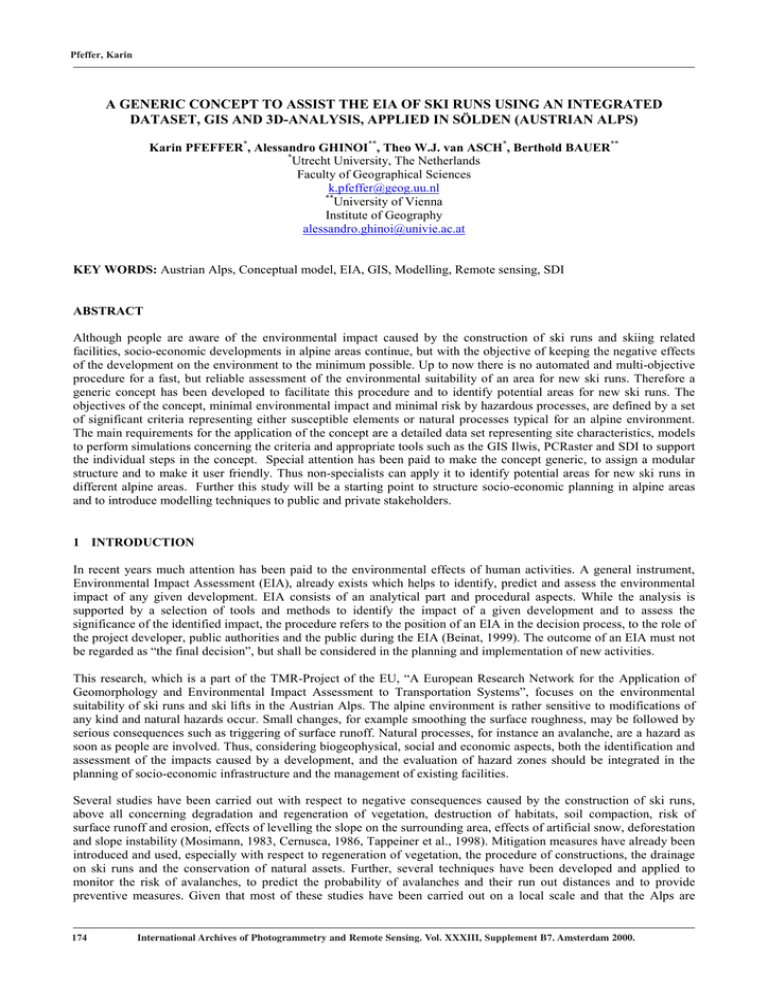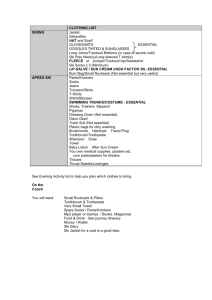A GENERIC CONCEPT TO ASSIST THE EIA OF SKI RUNS USING... DATASET, GIS AND 3D-ANALYSIS, APPLIED IN SÖLDEN (AUSTRIAN ALPS)
advertisement

Pfeffer, Karin A GENERIC CONCEPT TO ASSIST THE EIA OF SKI RUNS USING AN INTEGRATED DATASET, GIS AND 3D-ANALYSIS, APPLIED IN SÖLDEN (AUSTRIAN ALPS) Karin PFEFFER*, Alessandro GHINOI**, Theo W.J. van ASCH*, Berthold BAUER** * Utrecht University, The Netherlands Faculty of Geographical Sciences k.pfeffer@geog.uu.nl ** University of Vienna Institute of Geography alessandro.ghinoi@univie.ac.at KEY WORDS: Austrian Alps, Conceptual model, EIA, GIS, Modelling, Remote sensing, SDI ABSTRACT Although people are aware of the environmental impact caused by the construction of ski runs and skiing related facilities, socio-economic developments in alpine areas continue, but with the objective of keeping the negative effects of the development on the environment to the minimum possible. Up to now there is no automated and multi-objective procedure for a fast, but reliable assessment of the environmental suitability of an area for new ski runs. Therefore a generic concept has been developed to facilitate this procedure and to identify potential areas for new ski runs. The objectives of the concept, minimal environmental impact and minimal risk by hazardous processes, are defined by a set of significant criteria representing either susceptible elements or natural processes typical for an alpine environment. The main requirements for the application of the concept are a detailed data set representing site characteristics, models to perform simulations concerning the criteria and appropriate tools such as the GIS Ilwis, PCRaster and SDI to support the individual steps in the concept. Special attention has been paid to make the concept generic, to assign a modular structure and to make it user friendly. Thus non-specialists can apply it to identify potential areas for new ski runs in different alpine areas. Further this study will be a starting point to structure socio-economic planning in alpine areas and to introduce modelling techniques to public and private stakeholders. 1 INTRODUCTION In recent years much attention has been paid to the environmental effects of human activities. A general instrument, Environmental Impact Assessment (EIA), already exists which helps to identify, predict and assess the environmental impact of any given development. EIA consists of an analytical part and procedural aspects. While the analysis is supported by a selection of tools and methods to identify the impact of a given development and to assess the significance of the identified impact, the procedure refers to the position of an EIA in the decision process, to the role of the project developer, public authorities and the public during the EIA (Beinat, 1999). The outcome of an EIA must not be regarded as “the final decision”, but shall be considered in the planning and implementation of new activities. This research, which is a part of the TMR-Project of the EU, “A European Research Network for the Application of Geomorphology and Environmental Impact Assessment to Transportation Systems”, focuses on the environmental suitability of ski runs and ski lifts in the Austrian Alps. The alpine environment is rather sensitive to modifications of any kind and natural hazards occur. Small changes, for example smoothing the surface roughness, may be followed by serious consequences such as triggering of surface runoff. Natural processes, for instance an avalanche, are a hazard as soon as people are involved. Thus, considering biogeophysical, social and economic aspects, both the identification and assessment of the impacts caused by a development, and the evaluation of hazard zones should be integrated in the planning of socio-economic infrastructure and the management of existing facilities. Several studies have been carried out with respect to negative consequences caused by the construction of ski runs, above all concerning degradation and regeneration of vegetation, destruction of habitats, soil compaction, risk of surface runoff and erosion, effects of levelling the slope on the surrounding area, effects of artificial snow, deforestation and slope instability (Mosimann, 1983, Cernusca, 1986, Tappeiner et al., 1998). Mitigation measures have already been introduced and used, especially with respect to regeneration of vegetation, the procedure of constructions, the drainage on ski runs and the conservation of natural assets. Further, several techniques have been developed and applied to monitor the risk of avalanches, to predict the probability of avalanches and their run out distances and to provide preventive measures. Given that most of these studies have been carried out on a local scale and that the Alps are 174 International Archives of Photogrammetry and Remote Sensing. Vol. XXXIII, Supplement B7. Amsterdam 2000. Pfeffer, Karin characterised by a large spatial variability, also within small distances, the results of these studies may not be transferred to other areas or to a larger scale. Up to now decisions regarding the environmental aspect were mainly based on the legal framework and the assessment of individual experts, lacking an automated and multi-objective procedure. The aim of this study is the development of a generic concept to facilitate the process of the identification and assessment of environmental impacts and natural hazards in alpine areas. The purpose of the generic concept is to guide the user through the process of an environmental appraisal of an socioeconomic development to achieve an acceptable solution for a problem in relation to defined objectives and given site characteristics. In this paper only the analytical module of an EIA is considered, thus the emphasis is put on the design of guidelines to support the identification, prediction and the assessment of impacts and risks being possibly present in an alpine environment. The environmental analysis involves a certain set of actions, which depend upon data, scientific reliable models, expert knowledge and technology: 1. 2. 3. 4. inventory of site characteristics specification of potential changes and influences simulation of processes and probable events evaluation of model results This paper describes the generic concept and shows its application in a case study, in particular the ski area of Sölden, Tyrol (Austrian Alps). 2 METHODOLOGY 2.1 Outline of the concept The problems that could be expected in a ski area are mainly related to biomass production, diversity of plant species, geomorphologic assets, slope instability, runoff generation and erosion and the risk of avalanches. Therefore, these elements represent the significant EIA-criteria in the concept. Anybody concerned with the planning of new ski runs might be interested in the assessment of these criteria to minimise the environmental impact of a new development and to guarantee safety for the development and its environment. The assessment requires: 1. 2. 3. 4. Data representing the current situation Models to perform simulations Tools to execute the procedure Expert knowledge and field knowledge 2.1.1 Data Running the models that have been established in the generic concept, asks for an integrated data set, consisting of spatial, temporal and attribute information. Therefore spatially distributed data representing geomorphology and the current status of topographic and environmental features such as elevation, geology, relief, soil, vegetation, habitats, hydrology, land use and infrastructure are required in a high resolution. High resolution means a scale of +/- 1:25000, resulting in a pixel size of 25m in a grid. The dependence of natural processes on climate conditions implies the integration of climate data such as precipitation, temperature, wind and radiation, preferable on a daily basis. The consideration of historic data, for instance occurrence and frequency of past events, improves the selection of significant criteria, the understanding of processes and the design of statistical models based on joint conditional probability. 2.1.2 Models The selection of models is determined by the characteristic of the selected criteria, the current status of scientific knowledge in the modelling field, the spatial variability of alpine areas and the availability of data and resources. Therefore three different approaches are utilised, particularly process based modelling, statistical modelling and cartographic modelling, using the data from the common data set. Process based modelling was chosen for the simulation of biomass production, slope instability and runoff generation or erosion in space and time because of the available knowledge of physical processes. Avalanche records from the past International Archives of Photogrammetry and Remote Sensing. Vol. XXXIII, Supplement B7. Amsterdam 2000. 175 Pfeffer, Karin and a detailed species survey promote the use of statistical models for the prediction of avalanches and the reconstruction of plant species composition. Cartographic modelling is suggested for the prediction of the impact on geomorphologic assets. For all modelling approaches a detailed data set is required, which also implies the collection of field data. 2.1.3 Tools The implementation of the generic concept requires appropriate tools, among other items suitable software packages. The Geographic Information System ILWIS (ITC, 1998), the dynamic modelling package PCRaster (Wesseling et al., 1996) and the module Spatial Data Integration SDI (Chung et al., 1999), turned out to be capable tools for modelling. The GIS meets basic needs such as collection, storage, retrieval, transformation and display of data (Burrough et al., 1998), and is therefore a potential option for managing the integrated data set. PCRaster is also a GIS, but with an embedded programming language for cartographic and dynamic modelling (Wesseling et al., 1996) which enables the construction and run of models in space and time. SDI is a suitable tool for the integration and analysis of spatial data to support the prediction of a future situation, based on past information, present conditions and various probability theories. 2.1.4 Knowledge Expert knowledge and field knowledge is needed in every step of the generic concept, especially in the identification of significant criteria, the design of the models and the evaluation of the model results. Therefore emphasis must be put in the acquisition of process and site specific knowledge. 2.2 Special characteristics of the concept Special demands to the concept are being generic, modular and “user friendly”. Being generic enables the application of the model in different areas with similar characteristics, but conditions the use of standard available data. Usually, data, which can be retrieved from additional sources such as aerial photographs or satellite images, are available throughout the country, for instance elevation data. Unfortunately, detailed inventory of alpine environment is scarce. For example soil surveys are mostly restricted to potential agricultural areas and geomorphologic maps or species surveys are confined to those areas which have been selected for research. To compensate this drawback, guidelines for mapping spatial attributes are proposed. For each criterion stated in the general concept a model is proposed to measure the criteria. These models are arranged in a modular structure. While some problems are rather common, some problems are quite site specific. Thus the modular structure is suitable to adjust the concept to the area, for which it is applied. The condition of being “user friendly” requires the design of a system with an user-friendly interface, that is appropriate for planners and decision makers. The modular structure demands the generation of an interface for each criterion that will be joined together by a common interface. To facilitate the application, each step is documented in an user-guide, which also contains information about the kind of data needed for the analysis, methods for data conversion, the function of the model, and guidance for the interpretation of the model output. 3 CASE STUDY In this section the data set of the case study, the generation of the geomorphologic map, the assessment of the geomorphologic impact on natural assets, the prediction of avalanches, simulation of biomass production and the use of the individual model output is described. 3.1 Data set A digital elevation model (DEM) with a pixel size of 25m was derived from digital isolines. Analogue aerial photographs and digital orthophotos facilitated the generation of the geomorphologic map. Digital data concerning topography, land use, infrastructure and natural hazard were made available by the information system of Tyrol (TIRIS). Climate data, specifically temperature, precipitation, irradiation, wind and air humidity were retrieved from meteo stations in the surrounding, available on a daily basis and partly on a continuous scale with timesteps of 10 minutes. Missing data and more specific data, for instance data about geomorphology, vegetation, snow profiles or 176 International Archives of Photogrammetry and Remote Sensing. Vol. XXXIII, Supplement B7. Amsterdam 2000. Pfeffer, Karin infiltration capacity of the soil, were collected in the field or provided by special offices. Because of limited resources, satellite images are not considered, although they would add useful information for the simulation of snowmelt. Figure 1. Screen digitised geomorphologic features 3.2 Mapping missing data: generation of the geomorphologic map The geomorphologic map has been constructed in several steps, namely by interpreting analogue aerial photographs at a 1:15000 scale with the help of a stereoscope, screen digitising of the interpreted forms of the landscape using digital orthophotos at the scale of 1:36000 with a pixel resolution of 0.5 meters as a background (Figure 1), and detailed mapping of geomorphologic features in the field (July-August 1999). Figure 2. Sketch of the geomorphologic map After the fieldwork the geomorphologic map was completed at the 1:10000 scale, following representation guide lines proposed by the Italian National Group for Geography and Geomorphology (Pellegrini et al., 1993). (Figure 2). 3.3 Geomorphologic impact on natural assets using modelling tools in Ilwis The geomorphologic map and additional thematic maps were combined to identify the geomorphologic impact caused by the construction of ski runs and ski lifts. The geomorphologic map served to select the geomorphologic assets of the area. Then an asset map and a linked attribute table were developed, showing the spatial distribution of the assets, their scientific character and value (Panizza et al., 1996) Finally, the direct impacts (Cavallin et al., 1994) on the geomorphologic assets in terms of valuable surface loss were quantified by the overlay of the asset map with the ski run map. 3.4 Prediction of avalanches For the prediction of avalanches a specific technique will be developed, using a statistical approach (Chung et al., 1999). Within this different kind of information such as records from past snow avalanche events, details about the type of these avalanches, temporal series of climatologic data, snow profile records and topographic and geomorphologic characteristics will be integrated. First, causal factors favouring snow avalanches in the study area, their spatial distribution and their weight were identified. One of the causal factors, the roughness of the surface, was directly derived from the geomorphologic map by morphogenetic units out of the surficial deposits (Figure 3). International Archives of Photogrammetry and Remote Sensing. Vol. XXXIII, Supplement B7. Amsterdam 2000. 177 Pfeffer, Karin Other topographical factors were obtained from the DEM, in particular slope, an extremely important factor for snow avalanches, and aspect. Then the individual maps containing causal factors for avalanches were overlaid with the map showing the past snow avalanche events. Descriptive statistics were automatically created and displayed on a linked table. The next step will be the construction of a probabilistic model for the prediction of snow avalanche starting areas, integrating significant spatial data and statistics as described. Therefore the module SDI (Chung et al., 1997) will be used, resulting in a map showing the probability of the distribution of snow avalanche starting areas. The model output will be validated with another set of field data. Figure 3: Terrain roughness map on the left; the segments in different colours express different morphogenetic units and related grain size. 3.5 Simulation of biomass production Biomass production will be simulated by a process based model constructed in PCRaster, using modules of Wofost (Supit et al., 1994), a module simulating incoming potential solar radiation (van Dam, 1999) and additional scientifically reliable formulae. There were hardly any data available about grass vegetation in Sölden. Thus vegetation cover was mapped in the whole study area and species samples were taken on 145 points. Data reporting the production rate of the grass had to be collected in the field. The rate was determined by cutting the grass of defined areas, drying and weighing the grass. Topographic and other thematic data were retrieved from the base data set. Data concerning the interception of vegetation, soil properties and meteorological data were gathered on certain locations to complete the input for the growth model. The aim of simulating biomass production was to identify areas which are difficult to revegetate. Therefore the growth model will be applied in a test area to determine significant parameters of the growth of vegetation and then the information will be extrapolated to the whole area. The model output will be used to produce a map showing potential areas for new ski runs, that means areas, which have a high growth potential. It is assumed, that areas with a high growth potential are easy to revegetate under natural conditions. 3.6 Application of the individual models The results of the individual models are combined to generate a map showing potential areas for new ski runs in the Sölden ski area, referring to the objectives minimal environmental impact and minimal risk of natural hazards. 4 DISCUSSION AND CONCLUSIONS Although the generic approach is not completely elaborated, it may be argued that due to the flexibility and the modular structure it could be a useful instrument in the elaboration of planning and management alternatives and in the formulation and implementation of land use policies. The fact, that it is “user friendly” ensures a rather fast application, and it enlarges the number of potential users, since it is not restricted to specialists. Additionally, the consideration of multiple criteria avoids a biased assessment of a plan or program. But since models are used to represent spatial attributes and processes in a simplified form the results are accompanied by uncertainty. Therefore an analysis of error propagation should be done to compensate this artefact. Another problem is the demand for a detailed data set. Often data for specific purposes are not standard available, which implies the data collection in the field. This requires a lot of resources, which makes the application of such an approach unattractive. The characterisation of processes in alpine areas is rather difficult as they may differ within time and space. This fact restricts the application of the generic approach for any mountainous areas. The generic concept might be a useful starting point to structure socio-economic planning in an alpine environment and to introduce modelling techniques to public and private stakeholders. 178 International Archives of Photogrammetry and Remote Sensing. Vol. XXXIII, Supplement B7. Amsterdam 2000. Pfeffer, Karin ACKNOWLEDGMENTS We are grateful to all persons, who supported this study, special thanks to L. Booth, D. Karssenberg and P. Burrough. REFERENCES Beck, M.B., Jakeman, A.J. and McAleer, M.J., 1993. Construction and Evaluation of Models of Environmental Systems. In: Jakeman, A.J., Beck, M.B. and McAleer, M.J., Modelling in Environmental Systems, John Wiley & Sons Ltd., pp. 3-35. Beinat, E. et al., 1999. Geographical information systems and environmental impact assessment, Amsterdam, Draft 1.1. Burrough, P.A., 1998. Dynamic Modelling and Geocomputation. In: Longley et al. (eds.), Geocomputation a Primer. John Wiley & Sons, New York, pp. 165-191 Burrough, P.A., McDonnell, R. A., 1998. Principles of geographical information systems. Oxford University Press, New York Cavallin, A., Marchetti, M., Panizza, M. and Soldati, M., 1994. The role of Geomorphology in Environmental Impact Assessment. Geomorph., 9, pp. 143-153. Cernusca, Alexander, 1986. Ökologische Auswirkungen des Baues und Betriebes von Schipisten und Empfehlungen zur Reduktion der Umweltschäden, Strassbourg Chung, C.F., Fabbri, A. and van Westen, C., 1995. Multivariate regression analysis for landslide hazard zonation. In: Carrara, A. and Guzzetti, F. (eds.), Geographical Information Systems in Assessing Natural Hazards, pp. 107-133. Chung, Ch.J.F., Fabbri, A.G., 1999. Prediction models in spatial data analysis, Canada, Enschede, Draft ITC, 1998. ILWIS 2.21, User's Manual. ITC, Enschede Mosimann, T., 1983. Landschaftsökologischer Einfluss von Anlagen für den Massenskisport, Bodenzustand und Bodenstörungen auf planierten Skipisten in verschiedenen Lagen (Beispiel Crap Sogn Gion, Laax), Basler Beiträge zur Physiogeographie, Heft 3 Panizza, M., Fabbri, A., Marchetti, M. and Patrono A., 1996. Geomorphologic analysis and evaluation in environmental impact assessment. ITC Journal, 32, p. 67 PCI. 1997, PCI Reference Manual. Richmond Hill, Ontario, Canada. Pellegrini, G.B., Carton, A., Castaldini, D., Cavallin, A., D’Alessandro, L., Dramis, F., Gentili, B., Laureti, L., Prestininzi, A., Rodolfi, G., Sauro, U., Sorriso Valvo, M. and Spagna, V.,1993. Proposta di legenda geomorfologica ad indirizzo applicativo. Geogr. Fis. Dinam. Quat., 16, pp. 129-152, 1 carta. Supit, I., Hooijer, A.A. and van Diepen, C.A., 1994. System description of the WOFOST 6.0. crop simulation model implementation. In: CGMS Vol 1., Theory and algorithms. Joint Research Centre, Ispra, Italy Tappeiner, U., Cernusca, A., Pröbstl, U., 1998. Die Umweltverträglichkeitsprüfung im Alpenraum. Blackwell-Wiss. Verlag, Berlin, Wien Van Dam, O., 1999. Modelling incoming potential radiation on a land surface, Utrecht University Wesseling, C.G., Karssenberg, D., van Deursen, W.P.A. and Burrough, P.A., 1996. Integrating dynamic environmental models in GIS: the development of a Dynamic Modelling Language. Transactions in GIS, 1,1, pp. 40-48; Information available at http://www.geog.uu.nl/pcraster International Archives of Photogrammetry and Remote Sensing. Vol. XXXIII, Supplement B7. Amsterdam 2000. 179




